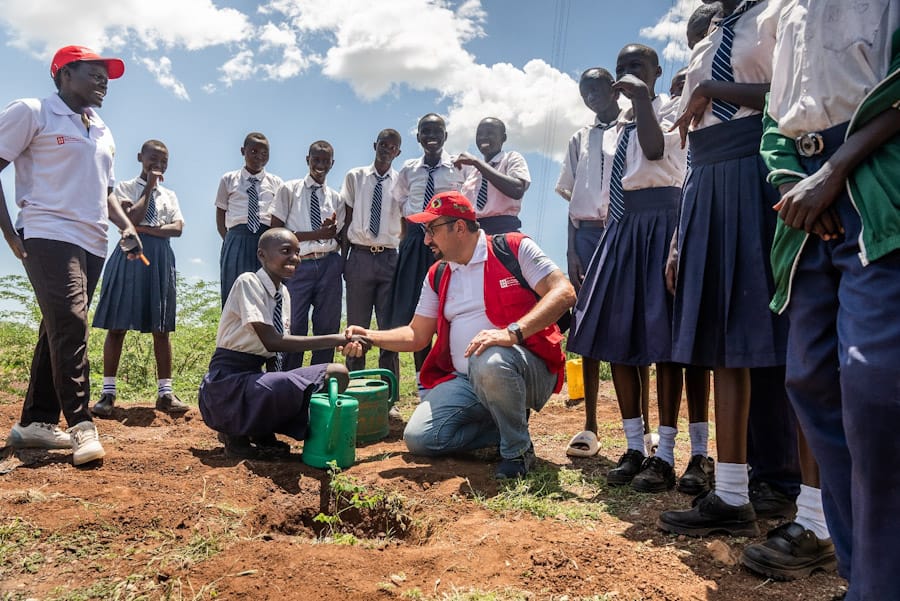From Dust to a Climate Action Hero.
 |
| Image credit: EAA |
In the barren and inhospitable Turkana region of northwestern Kenya, where nothing can grow without water, a young woman is giving life to the land and planting hope into the community. Though the winds are dry and the terrain is dusty, water is still more valuable than gold, and the young woman is carrying out her work to support agriculture in the region.
She is an 18-year-old South Sudanese refugee named Cecilia Adol Adar, who has found shelter in the Kakuma Refugee Camp, which is the residence of over 300,000 displaced people. In a situation where it is often hard to think about the future because of daily struggles of survival, the young woman is making a name for herself not only through her positive attitude but also by the fact that she is raising a voice for climate justice and green innovation.
Rising from the Dusty
Displaced by conflict in her native South Sudan, Cecilia found herself in Kakuma as a child. But unlike many who saw the refugee camp as a place of stagnation, she saw opportunity: “The environment here may be dry, but the minds are fertile,” she said in an interview with Education Above All (EAA).
Cecilia joined EAA’s “Youth Advocacy Programme”, which gave her tools and training to address the climate crisis. It was here that she discovered the power of grassroots solutions in tackling both environmental degradation and community hardship.
Cecilia’s work is absolutely transformative for her community:
Tree Planting in Arid Lands: Though Turkana is a quite hot and dry place, Cecilia embarked on tree planting campaign utilizing drought-resistant, indigenous species. “Even a single tree can alter a microclimate,” she said. According to FAO report, tree cover in such areas can significantly reduce soil erosion and increase rainfall retention.
Turning Invasive Species into School Furniture: Among the various green innovations of Cecilia one that stands out the most is her venture that has tremendously benefited the community. It involved the use of prosopis juliflora, thus an invasive species which has been plaguing Turkana for quite a long time. While others were scared and saw it as a threat, she saw good in it. Besides, she implemented the action plan through youth-led teams turning it into desks and chairs for local schools—thus going from a problem to a solution.
Clean Energy Advocacy: Additionally, it is worth noting that besides the above-mentioned achievements, she also undertakes energy advocacy among the youth by holding awareness programs on how to make briquettes as a most environmentally friendly alternative to firewood. Besides, she is a proponent of energy-efficient cooking stoves which according to GAA reduce indoor air pollution and climate-harming - emissions by up to 60%.
Empowering Through Beekeeping: One more get of her is the launching of beekeeping for the youths. Besides the bees themselves being income-providers through honey, which is the main source of income, they also help replenish biodiversity through their role as pollinators—a practice that will be indispensable in the face of the ongoing climate change that the region is experiencing.
Climate Action in a Conflict zone
Cecilia's activism is really one of a kind as it gets its energy from the junction between conflict and climate. Her story is a perfect example of how young refugees, who are usually left out of the environmental policies of the countries they live in, are actually the ones dealing with the impacts of climate change in the first place.
According to UNHCR report, highly climate-vulnarable nations hosts about 40% of refugees. These countries are also homes to 70% of refugees who flee from conflicts hence exposing them to dangers of climate and struggling to survive to due scarce resources. However, most of them are rarely given leadership roles. Cecilia is no longer a follower; she is going against this trend, not just for climate adaptation but also for the inclusion of young people in the worldwide climate conversation.
A voice on a Global Platform
Recently, her efforts have been recognized and she has become a Youth Climate Advocate with EAA. At various international forums, such as COP28 side sessions and UNHCR youth roundtables, she has expressed her views.
She emphasizes: "We do not only need help. We are the ones who take care of the land which provides us with shelter. If you equip us, we will grow change."
Cecilia's work reflects a growing global trend: young people in vulnerable environments are spearheading climate adaptation. Refugee-led environmental solutions are on the rise, frequently surpassing national efforts in terms of impact and innovation, according to reports from the Climate Resilience Network and UNEP.
Her narrative also forces development organizations to reconsider their strategy. Refugee communities should be seen as centers of green innovation rather than as burdens.
Cecilia Adol Adar is planting purpose rather than just trees. She is building a sustainable, just, and hopeful future in a place characterized by adversity.
Her story demonstrates that young people can take the lead in combating climate change, one tree, one briquette, and one voice at a time, even in the most challenging settings.



Comments
Post a Comment